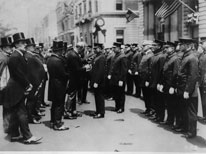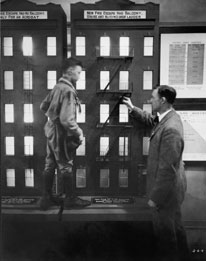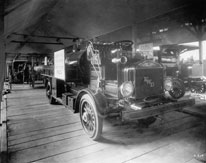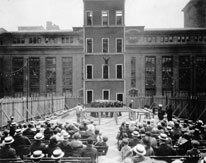Exhibition: A Pictorial Review, Greater New York's Silver Jubilee, May 26-June 23, 1923
A Digital Initiatives Department Exhibit, B. Davis Schwartz Memorial Library, February 14-March 20, 2011.
- Documentation of the Exhibit
- Jubilee
- Education
- NYC Fire Department
- NYC Police Department
- NYC Street Cleaning
New York City Fire Department

Mayor John F. Hylan Decorating Firemen for Bravery. (wrh_pr2_146.tif)
Fire Commissioner Thomas J. Drennan was appointed by Mayor John F. Hylan in 1918 and served in that post until 1926. The Commissioner had full charge of the protection of property from fire and the prevention and investigation of the origin of fires. Soon after Drennan’s appointment, to his surprise, the Uniformed Fire Fighter’s Association of New York decided to join the International Association of Fire Fighters, affiliated with the American Federation of Labor. As the City continued to develop and grow, the number of uniformed fire fighters doubled, pay increased, and work shifts allowed for a better quality of family life. In June 1923, the last of the volunteer fire houses in the Bronx was disbanded. Although volunteers who met the physical requirements of the Department were offered preference over other applicants, James W. Heller, foreman of the volunteers, was quoted as saying, “this probably marks the end for all of us.”

Model showing dangerous old type of fire escape which was simply a straight ladder without balconies and the present type of tenement house fire escape. wrh_pr2_048.tif)
After the City’s consolidation, the greatest challenges to the Fire Department and its apparatus were the growth of the City’s population, overcrowded tenement housing, numerous unregulated warehouses and the unprecedented height of new buildings. The warehouses created an exceptional threat to the safety of the City. For example, a spectacular warehouse fire in Greenwich Village on Jane Street in July of 1922 was caused by the explosion of magnesium powder used by the Navy for bombs and rockets. Two firemen were killed, 70 were hurt and 2,000 fled their homes. With damage estimated at over $1,000,000, Drennan’s response was swift and harsh. A squad of 500 men was assigned to inspect warehouses for fire hazards and violators were threatened with fines or imprisonment. As a result of the Jane Street Fire, the Manufacturer’s Transit Company was charged with manslaughter in the death of the two fire fighters. A year later, at the Jubilee event, Major Hylan, dressed in a cutaway coat with a boutonniere and striped trousers, removed his top hat to decorate firemen for bravery. Among them was Assistant Chief “Smokey Joe Martin” who was injured in the Jane Street fire.
Silver Jubilee Parade and Exhibits

Gasoline fuel and lubricating oil wagon now replacing the coal wagons which formerly have been used to replenish apparatus while working at a fire. (wrh_pr1_176.tif)
Fire Chief John Kenlon announced that the Fire Department would be represented in the Silver Jubilee Parade on May 26th by a brigade of four regiments, composed of 12 battalions, 25 pieces of apparatus and three bands, symbolizing the progress in the service of the Fire Department from 1898-1923. As the brigade passed the reviewing stand, Jubilee officers Governor Alfred E. Smith and Mayor John J. Hylan were given a marching salute. As reported in the New York Times the very next day, “the men of the Fire Department were met with a reception unsurpassed by any other division.”
Fire Department Training

Picture of drill school exemplifies each and every way the man who becomes a fireman has to go through School of Instruction. (wrh_pr1_179.tif)
The present Bureau of Training for the New York City Fire Department began in 1869 when the Captain of a given company, following a manual of instruction, was responsible for the training of his unit. A formal School of Instruction was created in 1883. Men were trained in the use of scaling ladders, ordinary ladders, lifelines, and when necessary, jumping from upper floors of tenements into nets, in order to save their own lives and rescue others. Later, new vehicles such as motorized trucks and water towers capable of reaching fires in multiple storied buildings were introduced. Fire escapes in every apartment with enclosed balconies were mandated by law. Training also stressed the handling, care and use of all tools and equipment employed to extinguish fires. Instruction reached a new level when the “Fire College” was established in 1911. It consisted of an Officers’ School, a School of Engineers, a Company School and a Probationary Firemen’s School. The current Fire College or Academy, as it is known today, is located on Randall’s Island.
